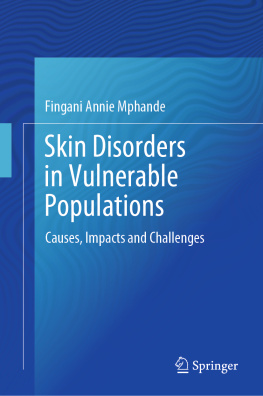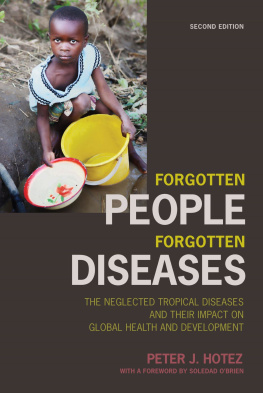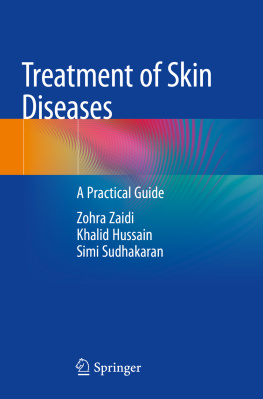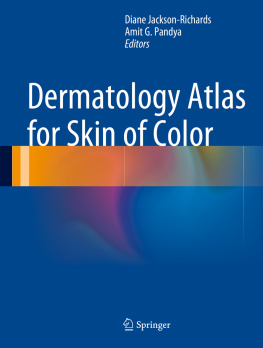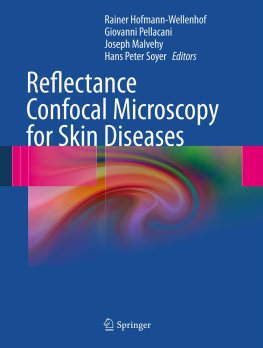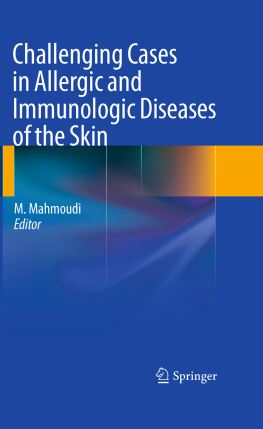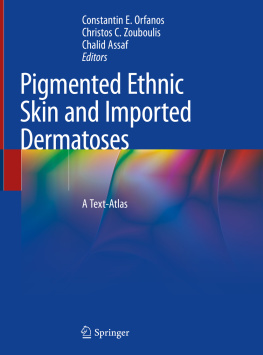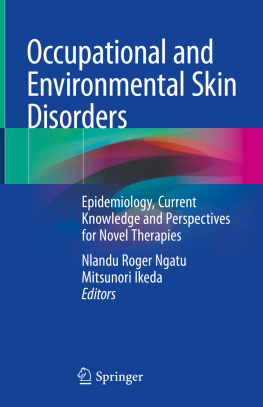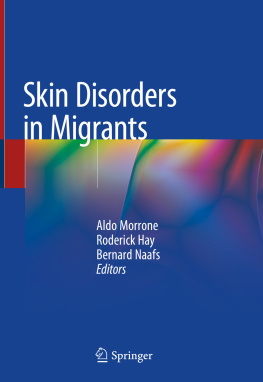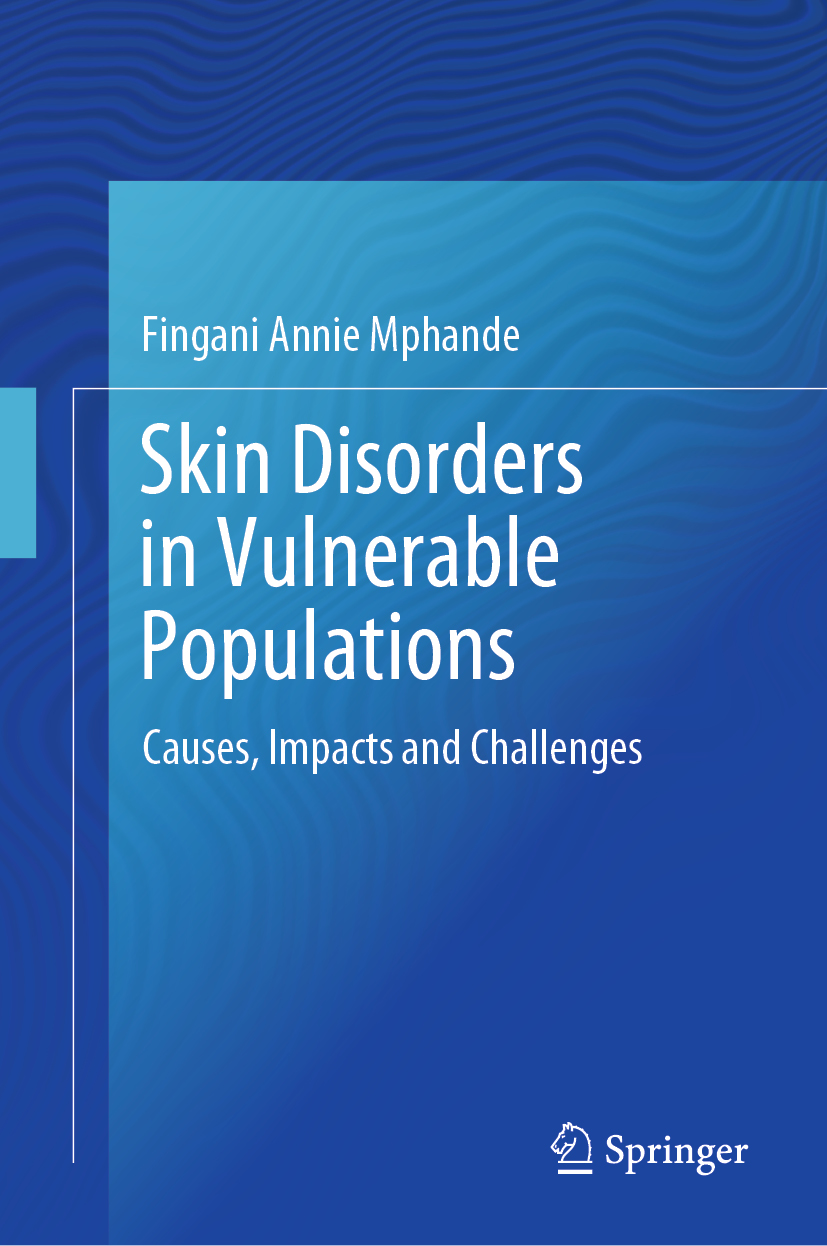Fingani Annie Mphande
Skin Disorders in Vulnerable Populations
Causes, Impacts and Challenges
Fingani Annie Mphande
Faculty of Medicine, King Mongkuts Institute of Technology Ladkrabang (KMITL), Bangkok, Thailand
Public Health and Infectious Disease Consultant, Bangkok, Thailand
ISBN 978-981-15-3878-0 e-ISBN 978-981-15-3879-7
https://doi.org/10.1007/978-981-15-3879-7
Springer Nature Singapore Pte Ltd. 2020
This work is subject to copyright. All rights are reserved by the Publisher, whether the whole or part of the material is concerned, specifically the rights of translation, reprinting, reuse of illustrations, recitation, broadcasting, reproduction on microfilms or in any other physical way, and transmission or information storage and retrieval, electronic adaptation, computer software, or by similar or dissimilar methodology now known or hereafter developed.
The use of general descriptive names, registered names, trademarks, service marks, etc. in this publication does not imply, even in the absence of a specific statement, that such names are exempt from the relevant protective laws and regulations and therefore free for general use.
The publisher, the authors and the editors are safe to assume that the advice and information in this book are believed to be true and accurate at the date of publication. Neither the publisher nor the authors or the editors give a warranty, expressed or implied, with respect to the material contained herein or for any errors or omissions that may have been made. The publisher remains neutral with regard to jurisdictional claims in published maps and institutional affiliations.
This Springer imprint is published by the registered company Springer Nature Singapore Pte Ltd.
The registered company address is: 152 Beach Road, #21-01/04 Gateway East, Singapore 189721, Singapore
For Syelwike Jenny Dorothy Mphande
Preface
Skin diseases (SDs) are a public health problem in many parts of the world. While other skin conditions are non-communicable, communicable (infectious) skin diseases pose a huge burden in low-income (LIC) as well as low-to-middle income countries (LMIC). Poor reporting from these regions has made it difficult to estimate the disease burden in the affected countries. The low mortality rate of skin diseases has resulted in less priority being attributed to these ailments compared to diseases with high mortality in resource-poor countries and communities. Some of these skin diseases are also part of what are known as neglected tropical diseases (NTDs), a set of debilitating diseases affecting certain populations in tropical countries.
Skin diseases, especially those affecting poor and/or vulnerable communities, receive very little coverage. The low mortality owing to these diseases has translated to limited resources being allocated to tackle this public health problem despite the enormous burden. Although most skin diseases are treatable, limited access to treatment and poor diagnosis have allowed for persistence of these diseases in limited resource communities. Finding ways to manage skin infections and disorders is essential to improve the health and livelihoods of the affected populations. Innovative methods are required to improve management and treatment of these ailments in vulnerable communities. Skin diseases not only impact the infected individual, but also their families, communities and livelihoods. Understanding skin diseases and their causes could assist in better infection, prevention and control in endemic populations.
Skin Disorders in Vulnerable PopulationsCauses, Impacts and Challengesexplores skin diseases, their aetiologies and impact on populations in resource-poor countries and communities. The book highlights the various skin diseases (disorders) affecting vulnerable communities in many parts of the world, including Africa, South East Asia, the South pacific and Oceania as well as South America. This book uniquely addresses the various types of skin diseases and how these ailments disrupt the lives of many physically, economically and socially. The book also compiles study reports from various settings and how each setting may present different challenges in implementation and management of infection prevention and control measures.Skin Disorders in Vulnerable PopulationsCauses, Impacts and Challengesalso highlights strategies that have led to successful elimination of diseases in some countries.
Skin Disorders in Vulnerable PopulationsCauses, Impacts and Challengesis aimed at igniting discussions on topics that are often sidelined and/or neglected and shed a light on the burden carried by vulnerable communities as they live with the impacts of skin diseases. Many of the affected may never report to any health facility for treatment due to fear of stigma, limited mobility, as well as lack of resources to meet the costs of treatment and/or long-term management. There is a need to encourage reporting of skin diseases in endemic areas to ensure better estimates of mortality and morbidity due to these disorders.
Several visits to a skin clinic in a low-income country setting and seeing the morbidity due to skin diseases was an inspiration to write this book. Most of those who came to seek treatment had travelled long distances and had tried alternative treatment which at this point seemed futile. The skin clinic was their last hope. Many of the patients were from limited resource backgrounds most of whom would not make it to a follow up visit due to lack of resources. This grim picture is repeated in many resource-poor countries and communities. The compilation of this book involved interviews with a dermatologist who has worked at one of these clinics for over 20 years, treating and managing patients with various skin disorders. Literature review on various peer-reviewed publications as well as documentaries provided a greater understanding at the impact of these diseases globally.
I hope this book will spark conversations and actions that will encourage not only research, but also availability of resources to assist in the management and treatment of skin diseases in vulnerable populations.
Skin Disorders in Vulnerable PopulationsCauses, Impacts and Challengesprovides an essential resource for academic institutions, researchers, students, governments, non-governmental organisations and all stakeholders involved in public health, as well as in rural development and various projects in vulnerable populations.
Fingani Annie Mphande
Bangkok, Thailand
April, 2020
Acknowledgements
I would like to thank Mr. J. Malanda for all the insights and conversations on the various skin diseases. His vast experience provided an invaluable resource to the compilation of this book.
My gratitude goes to all who provided permission for use of the photos in this book. Jessica Shortall, Jimmy Malanda, WHO and its partners who took the photos, thank you, your photos have helped show the indescribable impact of skin diseases. To all people and organisations that gave me support during this project, including publishers and editors, accept my sincere appreciation.
My publishers, Alexandra Westcott Campbell, Ameena Jafaar, and the team at Springer in Singapore and associated offices, thank you for your support and guidance.

